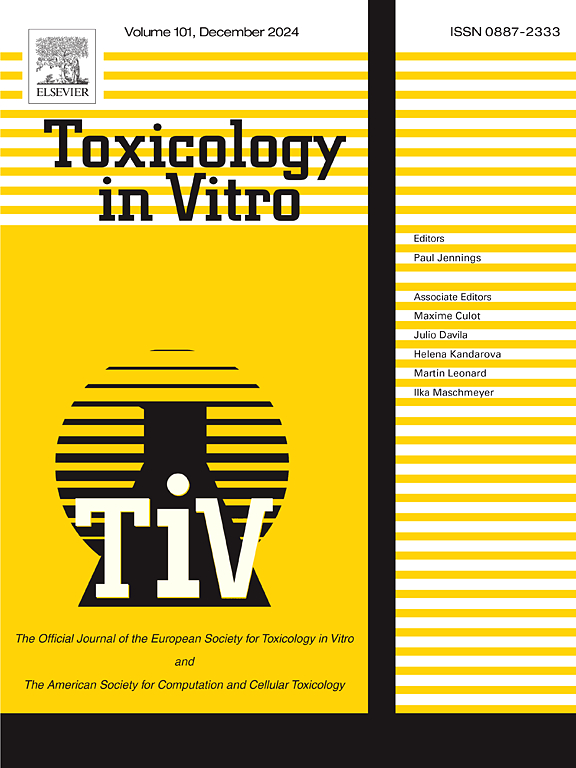氯酚(CPs)体外暴露的风险评估:硫转移酶(SULTs)活性的抑制。
IF 2.6
3区 医学
Q3 TOXICOLOGY
引用次数: 0
摘要
氯酚是一种常见的有机污染物,广泛应用于许多工业领域。目前的研究旨在检测CPs对硫转移酶(SULTs)的抑制作用。四种SULT亚型被多重CPs显著抑制。五氯酚对SULT1A1、SULT1B1和SULT1E1的半数抑制浓度(IC50)分别为0.31 μM、0.11 μM和1.86 μM。PCP对SULT1B1和SULT1E1表现出竞争性抑制作用。计算出PCP对SULT1B1和SULT1E1的抑制动力学(抑制类型和参数(Ki))分别为0.34 μM和0.56 μM。用硅对接来解释不同CPs之间的抑制差异。4-CP与SULT1A3的结合自由能为-4.92 kcal/mol, 2.4-DCP与SULT1A3的结合自由能为-5.63 kcal/mol。因此,2.4-DCP对SULT1A3的抑制活性较4-CP强,这可以很好地解释实验结果。这些结果对于从一个新的角度探索与CPs暴露相关的风险至关重要。本文章由计算机程序翻译,如有差异,请以英文原文为准。
Risk assessment of chlorophenols (CPs) exposure in vitro:Inhibition of sulfotransferases (SULTs) activity
Chlorophenols (CPs) are common organic pollutants widely used in many industries. The current study seeks to examine the inhibition of sulfotransferases (SULTs) by CPs. Four SULT isoforms were significantly inhibited by multiply CPs. Furthermore, half inhibition concentration (IC50) was calculated to be 0.31 μM, 0.11 μM and 1.86 μM for the inhibition of PCP (pentachlorophenol) towards SULT1A1, SULT1B1 and SULT1E1. PCP showed competitive inhibition towards SULT1B1 and SULT1E1.The inhibition kinetics (inhibition type and parameters (Ki)) values were calculated to be 0.34 μM and 0.56 μM for the inhibition of PCP towards SULT1B1 and SULT1E1, respectively. In silico docking was used to explain the inhibition difference among CPs. The binding free energy between 4-CP and SULT1A3 was −4.92 kcal/mol, and the binding free energy between 2.4-DCP and SULT1A3 was −5.63 kcal/mol. Therefore, 2.4-DCP exerted stronger inhibition activity towards SULT1A3 compared with 4-CP, which can well explain the experimental result. These results are crucial for exploring the risks associated with CPs exposure from a novel perspective.
求助全文
通过发布文献求助,成功后即可免费获取论文全文。
去求助
来源期刊

Toxicology in Vitro
医学-毒理学
CiteScore
6.50
自引率
3.10%
发文量
181
审稿时长
65 days
期刊介绍:
Toxicology in Vitro publishes original research papers and reviews on the application and use of in vitro systems for assessing or predicting the toxic effects of chemicals and elucidating their mechanisms of action. These in vitro techniques include utilizing cell or tissue cultures, isolated cells, tissue slices, subcellular fractions, transgenic cell cultures, and cells from transgenic organisms, as well as in silico modelling. The Journal will focus on investigations that involve the development and validation of new in vitro methods, e.g. for prediction of toxic effects based on traditional and in silico modelling; on the use of methods in high-throughput toxicology and pharmacology; elucidation of mechanisms of toxic action; the application of genomics, transcriptomics and proteomics in toxicology, as well as on comparative studies that characterise the relationship between in vitro and in vivo findings. The Journal strongly encourages the submission of manuscripts that focus on the development of in vitro methods, their practical applications and regulatory use (e.g. in the areas of food components cosmetics, pharmaceuticals, pesticides, and industrial chemicals). Toxicology in Vitro discourages papers that record reporting on toxicological effects from materials, such as plant extracts or herbal medicines, that have not been chemically characterized.
 求助内容:
求助内容: 应助结果提醒方式:
应助结果提醒方式:


